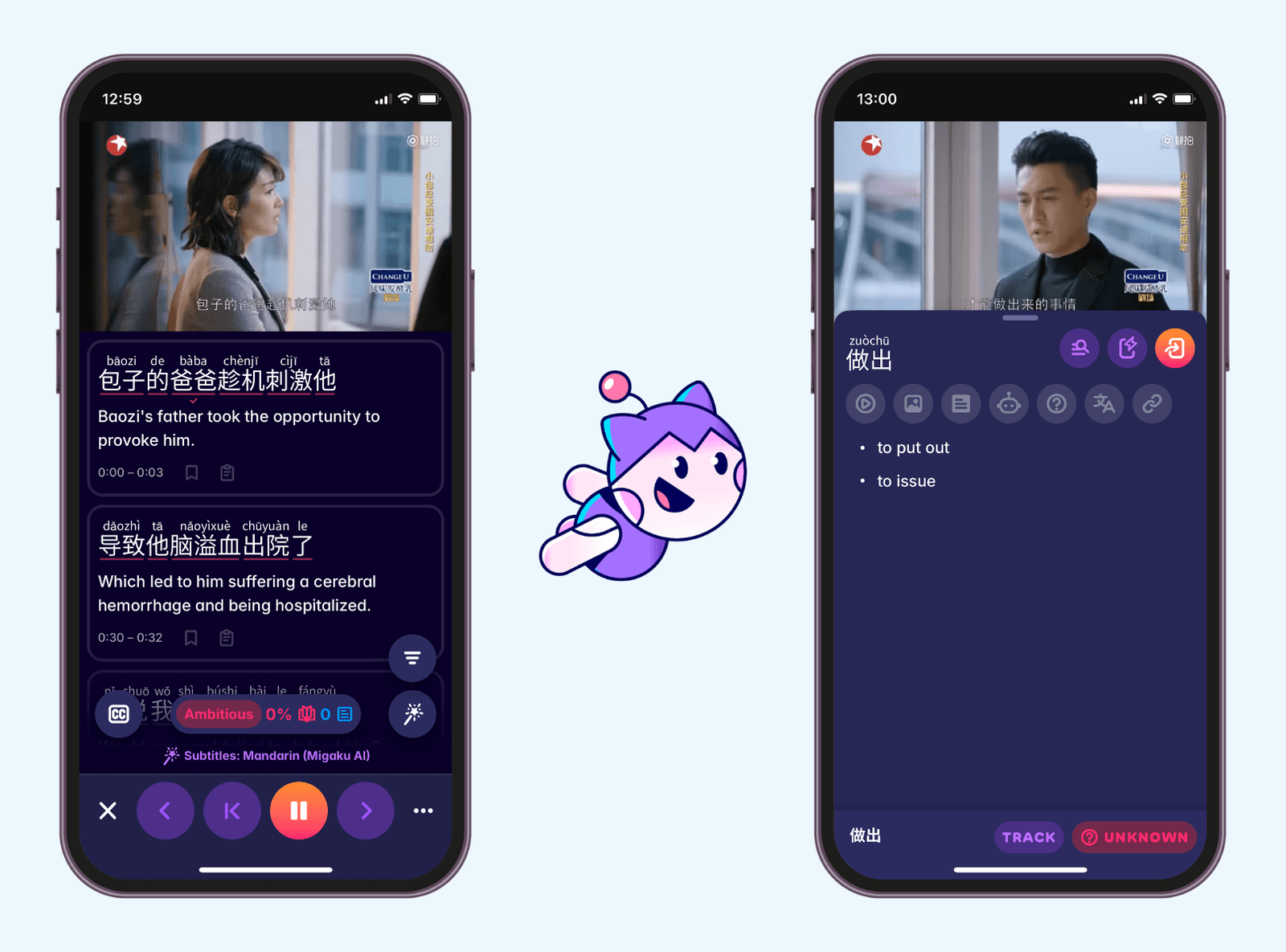Guide to Chinese Pronunciation: Enhance Your Mandarin Chinese with Common Rules and Pitfalls
Last updated: November 25, 2025

Mastering Chinese pronunciation is your passport to being understood! Speaking Mandarin is a lively dance of melodies. This language is built on five core tones that bring meaning to life: a flat, steady pitch, a rising pitch, a dipping curve, a sharp drop, and a light, mark-less neutral tone—and you’ve got the rhythm. Nail these "singing" tones, along with crisp consonants and vowels, and you’ll unlock clear communication, connect deeply, and turn confused looks into confident conversations.
The power of sound: know the five tones in Chinese pronunciation
In Mandarin Chinese, the concept of tone is fundamental. Unlike in English, where pitch conveys attitude or emotion, in Mandarin, the pitch contour of a syllable is an integral part of its meaning.
For example, means boss in English, while refers to husband or wife. The difference between these two words is only the tone of the second character. Therefore, mastering the proper tones of each Chinese word is the key to conveying clear information in the Chinese language!
The five Chinese tones: ¯, ˊ, ˇ, ˋ, and the neutral tone
- The first tone (¯) is a flat, level pitch marked with a macron:
"" , "" , "" . - The second tone (ˊ) rises, indicated by an acute accent:
"" , "" , "" . - The third tone (ˇ) dips and rises, shown with a caron:
"" , "" , "" . - The fourth tone (ˋ) falls sharply, marked by a grave accent:
"" , "" , "" . - The neutral tone, occurring on weak syllables, carries no mark:
"", "" , "" .
The flow and change of the tones
To use tones effectively, one must understand that they are not static; they change in flowing speech according to set rules, a process known as tone sandhi. While the tone-changing rules are more complicated, here are some common scenarios demonstrating these cases!
The most essential of these rules applies to the third tone.
- When one third tone is immediately followed by another, the first one changes and is pronounced as a second tone.
For instance, "你" (hello) is correctly spoken as "ní hǎo." - When three third tones appear in one phrase:
- if the first two characters can form a meaningful word, the first two third tones will be modified into the second tone.
For instance, "" (exhibition center) is correctly spoken as "zhán lán guǎn." - if the last two characters can form a meaningful word, the second third tone will be pronounced as the second tone.
For example, "" (little tiger) is pronounced as "xiǎo láo hǔ."
- if the first two characters can form a meaningful word, the first two third tones will be modified into the second tone.
The building blocks: understand the initials and finals in Mandarin Chinese pinyin
The phonetic system of Mandarin is systematically organized into two core components: initials and finals.
An initial is the consonant sound that begins a syllable, while a final is the vowel (or vowel-nasal combination) that follows it. For example, in the syllable "hǎo," "h" is the initial and "ǎo" is the final. Some syllables consist only of a final, like "ài" (love), demonstrating that while a final is always present, an initial is optional.
Learn Chinese pinyin chart
The key to accurately pronouncing the pinyin is to know the pronunciation of every consonant, vowel, and whole syllable in the pinyin chart first. Although the pinyin system looks similar to the English alphabet chart, the pronunciation is drastically different from the English one.
Pronounce each consonant, vowel, and whole syllable according to the audio of each Chinese character, but without the tone!
Consonants | Vowels | Whole Syllables |
|---|---|---|
b 波 | a 啊 | zhi 只 |
p 泼 | o 哦 | chi 吃 |
m 摸 | e 鹅 | shi 师 |
f 佛 | i 衣 | ri 日 |
d 的 | u 乌 | zi 兹 |
t 特 | ü 鱼 | ci 刺 |
n 呢 | ai 唉 | si 丝 |
l 了 | ei 诶 | yi 医 |
g 哥 | ui 微 | wu 屋 |
k 颗 | ao 凹 | yu 鱼 |
h 喝 | ou 欧 | ye 椰 |
j 鸡 | iu 油 | yue 约 |
q 期 | ie 椰 | yuan 元 |
x 西 | üe 约 | yin 因 |
zh 只 | er 儿 | yun 晕 |
ch 吃 | an 安 | ying 鹰 |
sh 师 | en 恩 | |
r 日 | in 因 | |
z 兹 | un 温 | |
c 刺 | ün 晕 | |
s 丝 | ang 昂 | |
y 医 | eng 哼 | |
w 屋 | ing 鹰 | |
ong 嗡 |
Tips for pronouncing consonants
If you're an English speaker, you need to pay attention to the difference between
- retroflex sounds (zh, ch, sh, r)and alveolar sounds (z, c, s),
- as well as aspirated consonants (p, t, k)and unaspirated consonants (b, d, g) .
Tips for pronouncing vowels
Some finals are simple single vowels, such as "a," "o," and "e," while others are compound vowels or combinations ending in "-n" or "-ng", where telling the difference between alveolar nasals and velar nasals is important.
Putting it all together: combine syllables and tones to pronounce like Chinese speakers
Simply put, Chinese pinyin pronunciation = initials + finals / (whole syllables) + tones. Therefore, to master Chinese pronunciation, learners need to be sure about the pronunciation of initials, finals, or the whole syllables, and the correct tone for that specific Chinese character.
At the same time, there are some common pitfalls to avoid in Mandarin Chinese pronunciation:
- Ignoring the importance of tones: It is very common for Chinese learners to ignore the differentiation of tones. Sometimes it is still understandable when the whole sentence makes sense, although there is no tone to each character. However, in the long run, if you wish to sound like a Chinese native, you need to memorize the tone of each character eventually.
- Confusing "sh" and "x": This confusion is very common because both consonants are pronounced differently in English words. In Mandarin pronunciation, "sh" is pronounced with the tongue curled back, while "x" is with the tongue flat and forward, and touching the back of the lower teeth.
Forge your path to confident speech with the help of media
Learning Chinese pronunciation through video offers an unparalleled multisensory advantage. Unlike static textbooks, videos provide immediate, dynamic models of speech, you not only hear the subtle distinctions in tones and the crisp articulation of initials and finals from native speakers, but you also see the crucial mouth shapes, tongue positions, and facial expressions that produce those sounds. This visual feedback is invaluable for mastering tricky elements like the "x" versus "sh" sounds or the correct lip rounding for "ü."
The great thing is that the Migaku app can generate subtitles and mark the pinyin of each subtitles for you when you are watching YouTube. By watching and playing back the videos several times, you can memorize and practice the pronunciation rules more efficiently!

FAQs
Media is the best teacher to improve your Chinese!
How about turning your screen into a dynamic classroom? Movies, songs, and podcasts immerse you in the authentic rhythm and melody of native speech.
If you consume media in Chinese, and you understand at least some of the messages and sentences within that media, you will make progress. Period.
Let's transform the tedious drills into a fun experience!